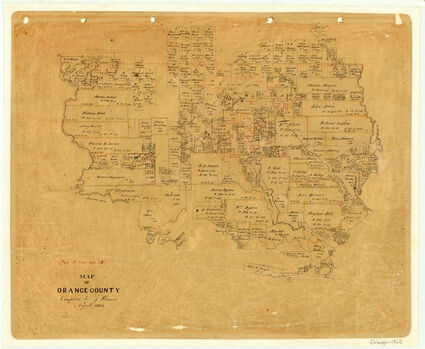Orange County had 'civil war' in 1856
Last updated 2/14/2023 at 7:15pm
What is now Orange County had an unusual start in that some of its original settlers were members of a free Black family, the Ashworths. Records show they first moved across the Sabine River from Calcasieu Parish, Louisiana, in 1831.
William Ashworth was the first to come to Texas, followed by brothers Aaron and Abner. Their father, James, who was also free, had been in Louisiana since the 1700s.
In the hardscrabble life of the pioneers, they had to work all the time to provide food, grow crops, and build houses. With few settlers around, some Ashworth men married White women, and some of the Ashworth women married White men.
The historian and law professor Jason A. Gilmer gives us a 21st Century look at the family by researching court records, deed records, state, and local records. He has written about the Ashworths for the Minnesota Journal of Law and Inequality in a 75-page paper called "Shades of Gray: The Life & Times of a Free Family of Color on Texas Frontier." He also included the Ashworth story in a book, "Slavery and Freedom in Texas."
Gilmer wrote "Race has never been a biological or natural fact; it is instead a social construct."
The Ashworth brothers and their children became successful ranchers and farmers here. They amassed hundreds of acres of property, thousands of heads of cattle, and even a few slaves.
In the 1830s, Mexico forbid slavery and slaves could not enter its territory, which included Orange County at the time. Part of the Texas rebellion against Mexico, which began in 1835, was the fight for the incoming U.S. settlers to own slaves. The Ashworths, despite their background, fought for Texas independence from Mexico.
William Ashworth fought with the Texians against the Mexican cavalry outside San Antonio in November 1835, known as the "grass fight." He was honorable discharged. He and brother Aaron later paid subsitute soldiers to fight for them against Mexico. One Ashworth died at Goliad.
After Texas gained independence from Mexico as the Republic of Texas, the congress passed laws forbidding free people of color or those of mixed race to live in the new country. It did not apply to the ones already living here.
Friends and neighbors of the Ashworths petitioned the government and Texas in 1840 passed the Ashworth Law, giving special attention to allow the family and descendants to stay and live free.
As background to this, what is now Orange County was part of Jefferson County in the 1830s. Orange County was split off in 1852, seven years after Texas joined the United States. It was called Orange County, either from orange trees George Patillo grew, or because of some native orange groves.
The only town in the county had been called "Green's Bluff" and it was renamed Madison in honor of the U.S. President James Madison, and became the county seat. However, Madison, Texas, was confused with Madisonville, Texas. The city's name was changed to Orange to match the county.
The changes to what is now Orange County means that we do not have census records for the county or for the town in 1850 and local population counts first come out in the 1860 census.
As the town grew and prospered, new White settlers were not fond of the Ashworths and their prosperity. Twenty-five years after the Ashworths moved across the Sabine, disputes grew to violence in what was called "The Orange County War if 1856," pitting the Ashworths and their friends against others.
The Orange County War broke out in the middle of June 1856, at the same time a new national political party, the Republicans held their first convention in Philadelphia and called for an end to slavery. Kentucky was the only Southern state to send a delegate.
The late historian W.T. Block wrote that in 1856, Madison was a thriving timber-producing center with about 600 people. A newspaper writer praised its "fairy tale appearance" of 150 white clapboard cottages encircling the crescent of the river. With its timber mills, Orange didn't have old-fashioned log cabins.
The town had five sawmills, two shipyards, numerous stores, a cotton warehouse, and six steamboats that traveled up and down the river. Numerous sailing boats and ships were also here.
Sons and daughters of the original Ashworth brothers married Whites and the family was truly one of mixed races. Even though the Ashworths were allowed to live freely, inter-racial marriages were illegal. As early as the 1840s, Jefferson County officials began filing charges against Ashworths for their so-called illegal marriages. There are no records that anyone was convicted of the charges.
Law professor Gilmer wrote that an agriculture census in 1850 included six members of the Ashworth family with Aaron the primary rancher in all of then-Jefferson County with 2,570 heads of cattle and an estimated 14,000 acres. Abner had 925 head of cattle, William had 900, Joshua had 550, and David and Aaron Jr. had 170 each.
The family also owned cows producing milk to make butter, along with pigs and sheep for wool.
As the Northern United States talked about banning slavery, secession talk across the Southern states, including Texas, grew. And so did talk around the town of Madison. With more white people coming, tensions increased against the Ashworths.
W.T. Block said the sentiments against the Ashworths were "steeped in jealousy and hatred."
Gilmer wrote that about the time that Orange County was formed, Aaron Ashworth hired a private school teacher to educate his children. That was another thing that made his neighbors jealous.
After Orange County was formed, a sheriff filed charges against William Ashworth and his nephew for playing cards, which was illegal, but likely not enforced because playing card games was a popular past time. Records show they each paid a $10 fine.
"The closer to the civil war, the less tolerance" the community showed for the Ashworths, Gilmer wrote.
On May 15, 1856, the tolerance ended. A deputy sheriff named Samuel Deputy arrested Clark Ashworth for stealing his hog. The details of the accused theft are unknown, but some historians question whether Clark needed to steal a hog because his family members owned dozens. Also, there was a question of whether the hog may have been one of the feral ones that roamed then, and even today.
Clark was released on bond secured by his cousin, Sam. Later that day, Sam encountered Deputy and challenged him to a gun fight outside of Madison. Many would call this a duel.
Deputy refused, and arrested Sam for violating the law of "abusive language" from a Black. Deputy took Sam before the local justice of the peace, who could not determine Sam's race by sight. Witnesses were called to show Sam had Black blood and therefore, could have broken the law.
After being found guilty, Sam was sentenced to receive 30 lashes from a whip on his bare back. That is the same punishment often given to slaves. Sam and other Ashworths were not happy.
What happened next is disputed because records are not available, though newspapers across the country reported on the happenings. Did Sam get released before his punishment, or did Sheriff Edward C. Glover let him escape?
Sam and another Ashworth cousin, Jack Bunch, ambushed Deputy. Deputy lived on a shellbank outside of town near Cow Bayou. In those days, most people traveled by boat, and Deputy was going home in a boat with a friend, A.C. Merriman.
Sam had changed clothes and disguised himself. He and cousin Jack were in a boat and came up to Deputy. Sam shot Deputy with a double-barrel shotgun and then smashed his head with the butt. Merriman had jumped overboard and held to the side of the boat and was left unharmed. Some accounts say the Ashworths were not mad at him and did not hurt him. He became a witness.
Sheriff Glover plays an important role in the story, though he had a checkered past. He had been arrested years earlier in Nacogdoches for passing counterfeit bonds, but was not convicted.
Glover was sympathetic to the Ashworths, but he had a job to do. He formed an eight-man posse and appointed Joshua Harmon as his deputy. The posse went through the county and were unable to find Sam and Jack Bunch.
Others in the town were angry at the sheriff and formed the "Moderators" as "friends of law and order." Sixty White men became vigilantes as the "committee of safety."
Those citizens sympathetic to the Ashworths became known as the "Regulators." For the next few weeks, Madison and Orange County were involved in their own civil war. Looking back, there were no good guys.
R.E. Russell, who moved to Madison as a boy with his family in 1854, wrote a memoir in 1911. He recalled that people living in town were afraid of the violence and did not burn candles at night. There were no lanterns at the time, and people were even afraid to sleep in their own beds.
The Moderators for "law and order" got infamous gunfighter Jack Cross of West Texas to fight on their side. On June 15, 1856, Cross got into an argument in town with Burwell Alexander and shot him in the neck. Dr. Mairs saw the shooting and went to help his friend. Cross shot the doctor in the head.
The Moderators kicked Glover out of office and took over. They told all the Ashworths and their supporters to leave the county or be killed.
During the war, houses were burned. The Moderators set the largest sawmill in town, along with the cut lumber, on fire when they thought Sam might be hiding there.
The fighting went on for two months and at least 12 men were killed.
Finally, a posse of Moderators on horses traveled north of town and tracked down Glover. He was found hiding in a house next to a house where his uncle, Jack Moore lived. Turns out his uncle was an accomplished counterfeiter of bills, bonds and land deeds. Jack Moore's printing plates and other equipment were also found.
Accounts vary on whether Glover knew his uncle was breaking the law. The posse shot and killed the counterfeiters and then shot and killed Glover. Finding the counterfeiters made the Moderators heroes in some news accounts.
Their effort to get rid of the mixed-race people of Orange County was successful. Some Ashworths went back to Louisiana. Others tried to stick it out, but their fortunes dwindled. Some of their land and cattle could have been taken illegally.
In 1860, the once wealthy Aaron had only a few acres and 20 head of cattle. Jefferson County, which included Orange, had 63 free people of color in the 1850 census. By 1860, Jefferson and Orange counties had only 27 free people of color.
Sam escaped west and reportedly joined the Confederate army when the U.S. Civil War broke out. He was said to be killed at the Battle of Shiloh.
18-year-old Jack Bunch, his cousin, was arrested near Columbus, Texas, and brought back for trial. The trial was moved to Beaumont on a change of venue. Jack was found guilty and executed by a cruel hanging. He was atop a ladder with the rope around his neck. The ladder was twisted around many times and then removed. He spun as he was choked to death.
One famous writer about the Orange County War of 1856 was Frederick Law Olmstead. In 2022, the country celebrated the 200th anniversary of his birth. He was the country's first landscape architect and is famous for designing New York's Central Park and the Chicago World's Fair of 1893, where Frances Ann Lutcher bought the first stained glass windows for the future First Presbyterian Church in Orange.
Keanu Reeves has been cast to play Olmstead in a Martin Scorsese production of the best-selling book, "Devil in the White City" about the fair and a serial killer.
Olmstead traveled through Texas on horseback in 1856 for the New York Times and published a book of his travels in the book "A Journey through Texas: Or a Saddle-Trip on the Southwest Frontier." Though he did not come to Orange County, he heard stories of the Ashworths and the "Orange County War of 1856" and wrote about Regulators and Moderators.
















Reader Comments(0)